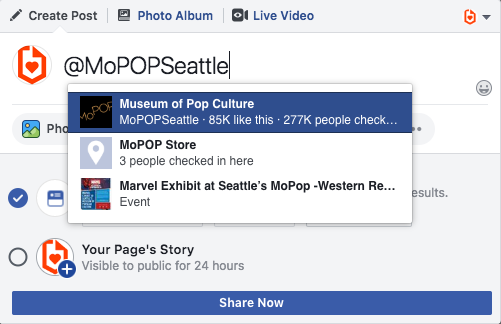Promoting your open call is a crucial step in ensuring that you receive a high quantity of quality submissions. If your organization isn’t already on social media, consider establishing an online presence to widen your reach.
On Facebook, the social media world is at your feet. Unlike other platforms, there are little to no regulations on character count or format. This could seem encouraging to some, but for others, it makes the task even more daunting. Here are the basics of using Facebook to promote your submission call.
Establish a Strong Page
The first step in promoting your call is to set up a Facebook page that accurately represents your organization. If you’re just getting started, create a Facebook business page, as opposed to a personal profile. You’ll want to make sure that your page name, profile picture, cover photo, and “about” section are updated to reflect your organization in an attractive, effective way.
Your page name is the tool that submitters will use to find your organization. As such, it’s important to ensure that your name on Facebook is consistent with the name you use elsewhere (i.e. on your website, on other social media platforms, etc.). Facebook also asks organizations to create a username—this is what shows up in the address bar for your Facebook page as well as underneath your page name.
Next, select two high-quality photos to use as your profile and cover pictures. These images function best when they are accurately sized and well-crafted to reflect your brand. DreamGrow offers a full list of ideal Facebook image sizes and dimensions. Finally, you’ll need to complete the “about” section of your page. Try to fill out as many fields as possible, since this is where Google and other search engines will pull information from.
Post Consistently
When a potential submitter arrives at your page, they’ll want to see that your organization is active and posting frequently. While inactivity can undermine your credibility, you also want to be careful not to overwhelm your submitters’ newsfeeds. Think about a schedule that makes sense for your organization and then try to maintain a frequency that is balanced and consistent in order to reach all of your fans. We recommend posting once daily or three times a week, depending on your organization.
You can use Facebook’s internal tool to schedule your posts ahead of time or try an external service like Buffer to help you manage the frequency.
Create Engaging, Shareable Content
Your number one goal is to engage with existing users and encourage them to share your content in order to grow your community. Since Facebook offers so many options for posting, it can be difficult to identify the approach that’s right for you. To keep users interested, try varying the format of your posts. Instead of only using text posts, you can incorporate videos, photos, polls, hashtags, and more. For more information, check out Buffer’s article on how to stand out on Facebook. As you experiment with different formats, be sure to monitor their performance by checking out your Page Insights. Page Insights will help you understand who’s engaging with your posts and track performance based on average reach and engagement.
In general, data shows that Facebook users react most strongly to posts between 80-100 characters. Although Facebook doesn’t limit your character count, you’ll still want to focus on keeping posts as short and simple as possible, since most online users are prone to skimming. Include key details, a call to action with a link to your form/website, and visuals to get the best engagement.
Here’s a great example from North American Review:

In this post, North American Review keeps their post short and sweet. They include the important details, a call to action, the link to their opportunity, and strong visuals to connect with users.
Join the Community (Likes, Shares, and Tags)
At the end of the day, social media is all about engaging with others. In order to get noticed on Facebook, you have to connect with your Facebook community. Once you become familiar with your community, you’ll start to pick up on the type of content that gains the most traction and can incorporate that into your own posting strategy.
You can connect with others in your community by liking their page. For example, if you run an arts organization, look for the Facebook pages of organizations doing the same work. When you do this, make sure that you like their page as your own Facebook page instead of your personal profile. You can also gain visibility by sharing posts from your colleagues and mentioning them in your own posts. If you’re using Submittable for your call, be sure to include @submittable in your post and we will happily share on our own Facebook page. Tag other pages by including their username with an “@” sign before it (example below).

Try Facebook Ads and Promoted Posts
You can achieve steps 1-4 without spending a dime, but if you want to put money beyond your promotional efforts, Facebook offers all the right tools to do so.
If the idea of tackling ad strategy seems daunting, you can start with promoted posts. With promoted posts, you can use the posts you’ve already created and simply pay Facebook to show them to more users. In short, promoted posts amp up your original posts by giving them an extra boost. If you’re looking for even more gusto, you can create ads independent from your Facebook page with Facebook Ads.
Resources for Facebook Ads & Promoted Posts:
- “The Facebook Boost Post Button: How to Use it and Get Results”
- “The Complete Guide to Getting Started with Facebook Ads”
Interested in promoting your submission call on multiple social media platforms? Check out our blog post on using Twitter to promote your open call.